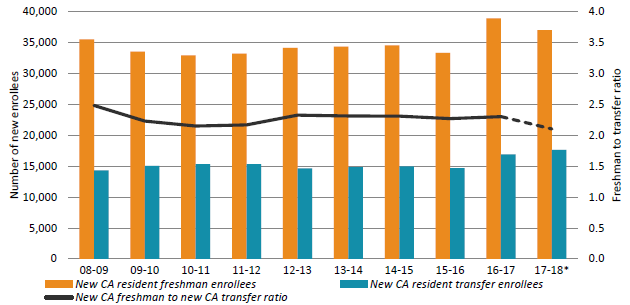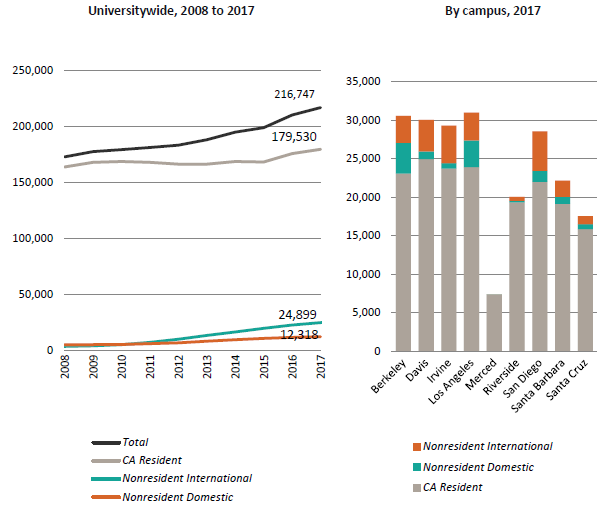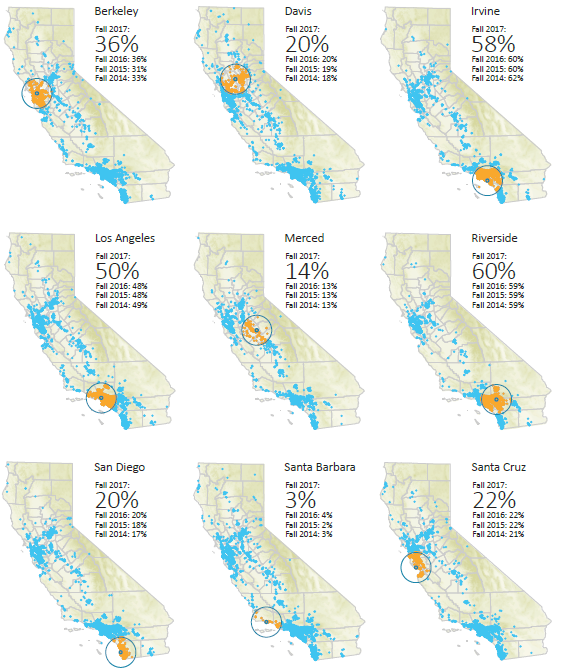History
On March 23, 1868, California Governor Henry Haight signed the charter that created the University of California, setting in motion the bold idea that college should be available to everyone. In 1869, UC opened its doors in Berkeley with 40 students and 10 faculty members. The University started admitting women equally with men the following year, and eight women registered in fall 1870, more than 20 years before Stanford did the same.
The University has grown both by opening its own new campuses and by merging with existing institutions. Since the first campus opened 150 years ago, UC has established nine campuses across California to fulfill the mission of educating California’s undergraduate students. In 1905, the University Farm Bill called for the establishment of a farm school for the University of California, which would become UC Davis; in 1919 the Los Angeles State Normal School became the Southern Branch of the University of California, now known as UCLA; UC Riverside merged with the Citrus Experiment Station and began teaching classes in 1954; UC San Diego grew out of the Scripps Institution of Oceanography and came into its current incarnation in 1960; UC Santa Barbara also began as a State Normal School and became a UC general campus in 1959; UC Santa Cruz and UC Irvine were designed as UC general campuses and both opened in 1965; UC Merced, located to serve the growing Central Valley, opened in 2005.
Goals
One of the University of California’s highest priorities is to ensure that a UC education remains accessible to all Californians who meet its admissions standards. This goal is articulated in California’s Master Plan for Higher Education, which calls for UC to admit all eligible freshmen and transfers with freshman eligibility, with the intention of capturing the top 12.5 percent of California public high school graduates. It also calls for UC to admit all qualified transfer students from California Community Colleges (CCCs).
Nearly 172,000 students applied as freshmen and over 38,000 as transfers for fall 2017. Campus admission decisions are based on a comprehensive review of qualifications, and campuses establish the incoming California resident class size based on state funding. Increased state support allowed the University to increase enrollment of California residents by nearly 4,000 in fall 2017 compared to fall 2016, following an increase of over 7,000 in fall 2016.
For 2017–18, UC also is estimated to have achieved its goal of enrolling a 2:1 ratio of freshmen to transfer California resident undergraduates, excluding Merced. The UC Transfer Pathways initiative supports this goal by helping community college students prepare for transfer admission to the most popular majors at UC campuses.
Admissions — freshmen
UC relies on a comprehensive review process to make admission decisions, considering not only completion of rigorous college preparatory courses, high school GPA and standardized test scores, but also talents, special projects, accomplishments in light of life experiences and circumstances, extracurricular activities and community service.
UC continues to reach its Master Plan goals by guaranteeing admission to California resident applicants who are either in the top nine percent of high school graduates statewide or the top nine percent of graduates from their own high school. Qualified freshman applicants are offered an opportunity to be admitted to another UC campus if they do not receive an offer of admission from the UC campuses to which they applied.
Admissions — transfers
A key recommendation stemming from the 2013 President’s Transfer Action Team was to streamline the transfer process for prospective UC students. To that end, the UC Transfer Pathways initiative set out to identify a common set of lower-division courses for each of UC’s 21 most popular majors among transfer applicants. These new Transfer Pathways would present a clear roadmap for prospective transfers to prepare for their major and be well positioned to graduate in a timely fashion from any UC campus. In April 2017, UC signed an agreement with the California Community Colleges (CCCs) to guarantee a place within the UC system to students who complete one of the transfer pathways and achieve the requisite grade point average (GPA). Almost all transfer students enter UC as upper-division juniors. Campus enrollment targets are based on state funding as well as capacity in major programs at the upper-division level.
Enrollments
The University enrolled 217,000 undergraduates in fall 2017. The University enrolls freshman and transfer students from every county of California, but students tend to enroll in campuses closer to their residence. UC’s Eligibility in the Local Context (ELC) program is designed to increase the overall geographic diversity of entrants and this goal is also addressed as a recommendation in the Transfer Action Team report.
Undergraduate Enrollment, Fall 2017
New Freshmen: 46,014
New Transfers: 20,151
Continuing Students: 150,582
TOTAL: 216,747
Source: UC Data Warehouse
As academic qualifications have improved over the last decade, UC has maintained access for populations that are historically underserved by higher education. In fall 2017, 38 percent of new undergraduates received Pell Grants—a marker for low-income status—and 42 percent did not have parent(s) who completed a four-year college degree.
The share of all undergraduates who are nonresident domestic and international students has increased in recent years, though their proportion is still much lower than at comparable public research universities. In 2016–17, the share of new undergraduates paying nonresident tuition went down after increasing in recent years. In May 2017, UC adopted a policy affirming that nonresident undergraduates “will continue to be enrolled in addition to, rather than in place of, funded California undergraduates at each campus.” The policy also caps nonresident enrollment at 18 percent for five UC campuses (Davis, Merced, Riverside, Santa Barbara and Santa Cruz) and capped nonresident enrollment for the remaining four campuses (Berkeley, Irvine, Los Angeles and San Diego) at the proportion each campus enrolls in 2017–18.
Having California students learn and live alongside students from backgrounds and cultures different from their own is part of a world-class educational experience. California students also benefit from the extra tuition paid by nonresident undergraduates, which is about $28,000 more than the amount paid by residents. That tuition helps to fund faculty hires, instructional technology, student advising and other services that directly benefit California students.
Admissions and enrollment trends
Freshman applicants have more than tripled over the past two decades, averaging six percent growth per year. In fall 2017, the number of applicants increased three percent compared to the previous year while the number of students admitted went down slightly (less than one percent) (1.1.1).
Fall transfer applicants nearly doubled over the last 20 years, with average annual growth of three percent. In fall 2017, transfer applicants went down four percent compared to the previous year, while admits and enrollees both went up three percent (1.1.2).
The Master Plan specifies that the University maintain a 60:40 ratio of upper-division to lower-division students, which corresponds to a 2:1 ratio of new California resident freshmen to new California resident transfers. UC has moved closer to that ratio, from 2.3:1 in recent years to an estimated 2.1:1 in 2017–18 (universitywide). The universitywide ratio (excluding Merced) is estimated to be 2.0:1 for 2017-18, achieving the systemwide goal for this metric (1.1.3).
Overall undergraduate enrollment (new and continuing students) continued to grow in fall 2017. Total enrollment was nearly 217,000 in fall 2017, up three percent from the year before. This includes an increase in California residents of nearly 4,000, following an increase of over 7,000 in fall 2016 (1.1.4).
About 42 percent of UC’s entering students are first-generation, meaning neither parent graduated from a four-year college. These students are more likely to be from an underrepresented group, to have a first language other than English, to enter as a transfer student, to be female and/or to have a lower income than students with at least one parent who graduated from a four-year college (1.2.1).
Academic preparation
Freshmen entering UC are increasingly well prepared, as shown by changes in the number of college preparatory courses, high school GPA and test scores over time (1.3.1). Transfer students are also increasingly well prepared, as measured by college GPA (1.3.2).
Geographic origins and nonresidents
UC has a lower proportion of out-of-state undergraduates than other public Association of American University (AAU) comparators. In fall 2016, only 16.5 percent of UC’s enrollees were out-of-state or international, compared with 28.7 percent for other AAU publics (1.4.1). About 34 percent of freshmen and 46 percent of transfer students entering UC campuses come from within 50 miles of campus. These numbers are quite stable and have actually risen slightly over the past few years (1.4.2, 1.4.3). Although the share of all undergraduates paying nonresident tuition has gone up in recent years, the proportion of new undergraduate students paying nonresident tuition went down in 2016–17 (1.4.4).
Looking ahead
The University is committed to sustaining access and educating as many California residents as it can. UC, in the last two years, has already achieved its three-year plan to increase California undergraduate resident full-time equivalent (FTE) enrollment by 10,000. Next year, it is planning to increase California resident FTE enrollment by at least another 2,000.
For more information
UC admissions data:















